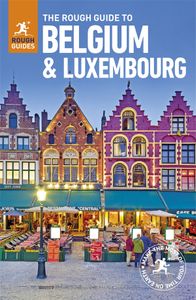South of the centre: St-Gilles, avenue Louise and Ixelles
Cobwebbed by tiny squares and narrow streets, home to a plethora of local bars and many of the capital’s finest Art Nouveau houses, the neighbouring areas of St-Gilles and Ixelles, just south of the petit ring, make a great escape from the razzmatazz of the city centre. St-Gilles, the smaller of the two communes, does have patches of inner-city decay, but it gets more beautiful the further east it spreads, its run-down streets soon left behind for attractive avenues interspersed with dignified squares. Ixelles, for its part, is one of the capital’s most interesting and exciting outer areas, with a diverse street-life and café scene. Historically something of a cultural crossroads, Ixelles has long drawn artists, writers and intellectuals – Karl Marx, Auguste Rodin and Alexandre Dumas all lived here – and today it retains an arty, sometimes Bohemian feel. Ixelles is cut into two by avenue Louise, a prosperous corridor that is actually part of the city – a territorial anomaly inherited from Léopold II, who laid it out and named it after his eldest daughter in the 1840s. Some of Brussels’ premier hotels, shops and boutiques flank the northern reaches of the avenue and further along is the enjoyable Musée Constantin Meunier, sited in the sculptor’s old house.
More than anything else, however, it’s the superb range of Art Nouveau buildings clustering the streets of St-Gilles and Ixelles that really grab the attention. Many of the finest examples are concentrated on and around the boundary between the two communes – in between chaussée de Charleroi and avenue Louise – and it’s here you’ll find Horta’s own house and studio, now the glorious Musée Victor Horta, one of the few Art Nouveau buildings in the country fully open to the public. Access to most of the city’s Art Nouveau buildings is restricted, so you can either settle for the view from outside, or enrol on one of ARAU’s specialist Art Nouveau tours.
Musée Victor Horta
The best place to start a visit to St-Gilles is the delightful Musée Victor Horta (wwww.hortamuseum.be), just off the chaussée de Charleroi at rue Américaine 25 and reachable by tram #92 from place Louise. The museum occupies the two houses Horta designed as his home and studio at the end of the nineteenth century, and was where he lived until 1919. The exterior sets the tone, a striking re-working and re-ordering of what was originally a modest terraced structure, the fluidity of the design incorporating almost casually knotted and twisted ironwork. Yet it is for his interiors that Horta is particularly famous. Inside is a sunny, sensuous dwelling exhibiting all the architect’s favourite flourishes – wrought iron, stained glass, ornate furniture and panelling made from several different types of timber. The main unifying feature is the staircase, a dainty spiralling affair, which runs through the centre of the house illuminated by a large skylight. Decorated with painted motifs and surrounded by mirrors, it remains one of Horta’s most magnificent and ingenious creations, giving access to a sequence of wide, bright rooms. Also of interest is the modest but enjoyable selection of paintings, many of which were given to Horta by friends and colleagues, including works by Félicien Rops and Joseph Heymans.
Horta’s progress
The son of a shoemaker, Victor Horta (1861–1947) was born in Ghent, where he failed in his first career, being unceremoniously expelled from the city’s music conservatory for indiscipline. He promptly moved to Paris to study architecture, returning to Belgium in 1880 to complete his internship in Brussels with Alphonse Balat, architect to King Léopold II. Balat was a traditionalist, partly responsible for the classical facades of the Palais Royal – among many other prestigious projects – and Horta looked elsewhere for inspiration. He found it in the work of William Morris, the leading figure of the English Arts and Crafts movement, whose designs were key to the development of Art Nouveau. Taking its name from the Maison de l’Art Nouveau, a Parisian shop which sold items of modern design, Art Nouveau rejected the imitative architectures which were popular at the time – Neoclassical and neo-Gothic – in favour of an innovatory style characterized by sinuous, flowing lines. In England, Morris and his colleagues had focused on book illustrations and furnishings, but in Belgium Horta extrapolated the new style into architecture, experimenting with new building materials – steel and concrete – as well as traditional stone, glass and wood.
In 1893, Horta completed the curvaceous Hôtel Tassel, Brussels’ first Art Nouveau building (“hôtel” meaning town house). Inevitably, there were howls of protest from the traditionalists, but no matter what his opponents said, Horta never lacked work again. The following years – roughly 1893 to 1905 – were Horta’s most inventive and prolific. He designed over forty buildings, including the Hôtel Solvay, the Hôtel Max Hallet, and his own beautifully decorated house and studio, now the Musée Victor Horta. The delight Horta took in his work is obvious, especially when employed on private houses, and his enthusiasm was all-encompassing – he almost always designed everything from the blueprints to the wallpaper and carpets. He never kept a straight line or sharp angle where he could deploy a curve, and his use of light was revolutionary, often filtering through from above, with skylights and as many windows as possible. Horta felt that the architect was as much an artist as the painter or sculptor, and so he insisted on complete stylistic freedom; curiously, he also believed that originality was born of frustration, so he deliberately created architectural difficulties, pushing himself to find harmonious solutions. It was part of a well-thought-out value system that allied him with the political Left; as he wrote, “My friends and I were reds, without however having thought about Marx or his theories”.
Completed in 1906, the Grand Magasin Waucquez department store was a transitional building signalling the end of Horta’s Art Nouveau period. His later works were more Modernist constructions, whose understated lines were a far cry from the ornateness of his earlier work. In Brussels, the best example of his later work is the Palais des Beaux Arts (BOZAR) of 1928.
Train station names
When you first arrive, the city’s bilingual signage can be very confusing, especially with regard to the names of the three main train stations: Bruxelles-Nord (in Flemish Brussel-Noord), Bruxelles-Centrale (Brussel-Centraal) and, most bewildering of the lot, Bruxelles-Midi (Brussel-Zuid). To add to the puzzle, each of the three adjoins a métro station – respectively the Gare du Nord (Noordstation), Gare Centrale (Centraal Station) and Gare du Midi (Zuidstation).
The Upper Town
From the heights of the Upper Town, the Francophile ruling class long kept a beady eye on the proletarians down below, and it was here they built their palaces and mansions, churches and parks. Political power is no longer concentrated hereabouts, but the wide avenues and grand architecture of this aristocratic quarter – the bulk of which dates from the late eighteenth and nineteenth centuries – have survived pretty much intact, lending a stately, dignified feel that’s markedly different from the bustle of the Lower Town.
The Lower Town ends and the Upper Town begins at the foot of the sharp slope which runs north to south from one end of the city centre to the other, its course marked – in general terms at least – by a wide boulevard that’s variously named Berlaimont, L’Impératrice and L’Empereur. This slope is home to the city’s cathedral, but otherwise is little more than an obstacle to be climbed by a series of stairways. Among the latter, the most frequently used are the covered walkway running through the Galerie Ravenstein shopping arcade behind the Gare Centrale, and the open-air stairway that climbs up through the stodgy, modern buildings of the so-called Mont des Arts. Léopold II gave the area its name in anticipation of a fine art museum he intended to build, but the project was never completed, and the land was only properly built upon in the 1950s.
Above the rigorous layout of the Mont des Arts lie the rue Royale and rue de la Régence, which together make up the Upper Town’s spine, a suitably smart location for the outstanding Musées Royaux des Beaux Arts, the pick of Belgium’s many fine art collections, the surprisingly low-key Palais Royal, and the entertaining Musée des Instruments de Musique (MIM). Further south, rue de la Régence soon leads to the well-heeled Sablon neighbourhood, whose antique shops and chic bars and cafés fan out from the medieval church of Notre Dame du Sablon. Beyond this is the monstrous Palais de Justice, traditionally one of the city’s most disliked buildings.
Musées Royaux des Beaux Arts
On the edge of place Royale, the Musées Royaux des Beaux Arts (wwww.fine-arts-museum.be) holds Belgium’s most satisfying all-round collection of fine art, a vast hoard that is exhibited in three interconnected museums, one displaying modern art from the nineteenth century onwards, a second devoted to René Magritte, and a third to older works. Finding your way around is made easy by the English-language, colour-coded museum plan issued at the information desk behind the entrance. The museum also hosts a prestigious programme of temporary exhibitions (colour-coded red on the museum plan) for which a supplementary admission fee is usually required.
Musée d’Art Ancien
In the Musée d’Art Ancien, the blue area displays paintings of the fifteenth and sixteenth centuries, including the Flemish primitives and the Bruegels, and the brown area concentrates on paintings of the seventeenth and eighteenth centuries, with the collection of Rubens (for which the museum is internationally famous) as a particular highlight.
The museum owns several paintings by Rogier van der Weyden (1399–1464), who moved to Brussels from his home town of Tournai (in today’s southern Belgium) in the 1430s, becoming the city’s official painter shortly afterwards. When it came to portraiture, Weyden’s favourite technique was to highlight the features of his subject – and tokens of rank – against a black background. His Portrait of Antoine de Bourgogne is a case in point, with Anthony, the illegitimate son of Philip the Good, casting a haughty, tight-lipped stare to his right while wearing the chain of the Order of the Golden Fleece and clasping an arrow, the emblem of the guild of archers.
Weyden’s contemporary, Leuven-based Dieric Bouts (1410–75) is well represented by the two panels of his Justice of the Emperor Otto. The story was well known: in revenge for refusing her advances, the empress accuses a nobleman of attempting to seduce her. He is executed, but the man’s wife remains convinced of his innocence and subsequently proves her point by means of an ordeal by fire – hence the red-hot iron bar she’s holding. The empress then receives her just desserts, being burnt on the hill in the background.
One of the museum’s most interesting paintings is a copy of Temptations of St Anthony by Hieronymus Bosch (1450–1516); the original is in Lisbon’s Museu Nacional. No one is quite sure who painted this triptych – it may or may not have been one of Bosch’s apprentices – but it was certainly produced in Holland in the late fifteenth or early sixteenth century. The painting refers to St Anthony, a third-century nobleman who withdrew into the desert, where he endured fifteen years of temptation before settling down into his long stint as a hermit. It was the temptations that interested Bosch – rather than the ascetic steeliness of Anthony – and the central panel has an inconspicuous saint sticking desperately to his prayers surrounded by all manner of fiendish phantoms. The side panels develop the theme – to the right Anthony is tempted by lust and greed, and on the left Anthony’s companions help him back to his shelter after he’s been transported through the skies by weird-looking demons.
Another leading Flemish artist, Quinten Matsys (1465–1530) is well represented by the Triptych of the Holy Kindred. Matsys’ work illustrates a turning point in the development of Low Country painting, and in this triptych, completed in 1509, he abandons the realistic interiors and landscapes of his Flemish predecessors in favour of the grand columns and porticoes of the Renaissance. Each scene is rigorously structured, its characters – all relations of Jesus – assuming lofty, idealized poses.
René Magritte
René Magritte (1898–1967) is easily the most famous of Belgium’s modern artists, his disconcerting, strangely haunting images a familiar part of popular culture. Born in a small town just outside Charleroi, he entered the Royal Academy of Fine Arts in Brussels in 1915, and was a student there until 1920. His appearances were, however, few and far between as he preferred the company of a group of artists and friends fascinated with the Surrealist movement of the 1920s. Their antics were supposed to incorporate a serious intent – the undermining of bourgeois convention – but the surviving home movies of Magritte and his chums fooling around don’t appear very revolutionary today.
Initially, Magritte worked in a broadly Cubist manner, but in 1925, influenced by the Italian painter Giorgio de Chirico, he switched over to Surrealism and almost immediately stumbled upon the themes and images that would preoccupy him for decades to come. His work incorporated startling comparisons between the ordinary and the extraordinary, with the occasional erotic element thrown in. Favourite images included men in bowler hats, metamorphic figures, enormous rocks floating in the sky, tubas, fishes with human legs, bilboquets (the cup and ball game), and juxtapositions of night and day – one part of the canvas lit by artificial light, the other basking in full sunlight. He also dabbled in word paintings, mislabelling familiar forms to illustrate (or expose) the arbitrariness of linguistic signs. His canvases were devoid of emotion, deadpan images that were easy to recognize but perplexing because of their setting – perhaps most famously, the man in the suit with a bowler hat and an apple for a face.
He broke with this characteristic style on two occasions, once during the war – in despair over the Nazi occupation – and again in 1948, to revenge long years of neglect by the French artistic establishment. Hundreds had turned up to see Magritte’s first Paris exhibition, but were confronted with crass and crude paintings of childlike simplicity. These so-called Vache paintings created a furore, and Magritte beat a hasty artistic retreat behind a smokescreen of self-justification. These two experiments alienated Magritte from most of the other Surrealists, but this was of little consequence as he was picked up and popularized by an American art dealer, Alexander Iolas, who made him very rich and very famous.
Magritte and his family lived in Jette, a suburb of Brussels, until the late 1950s, and the house is now the Musée René Magritte. He died in 1967, shortly after a major retrospective of his work at the Museum of Modern Art in New York confirmed his reputation as one of the great artists of the twentieth century.
























